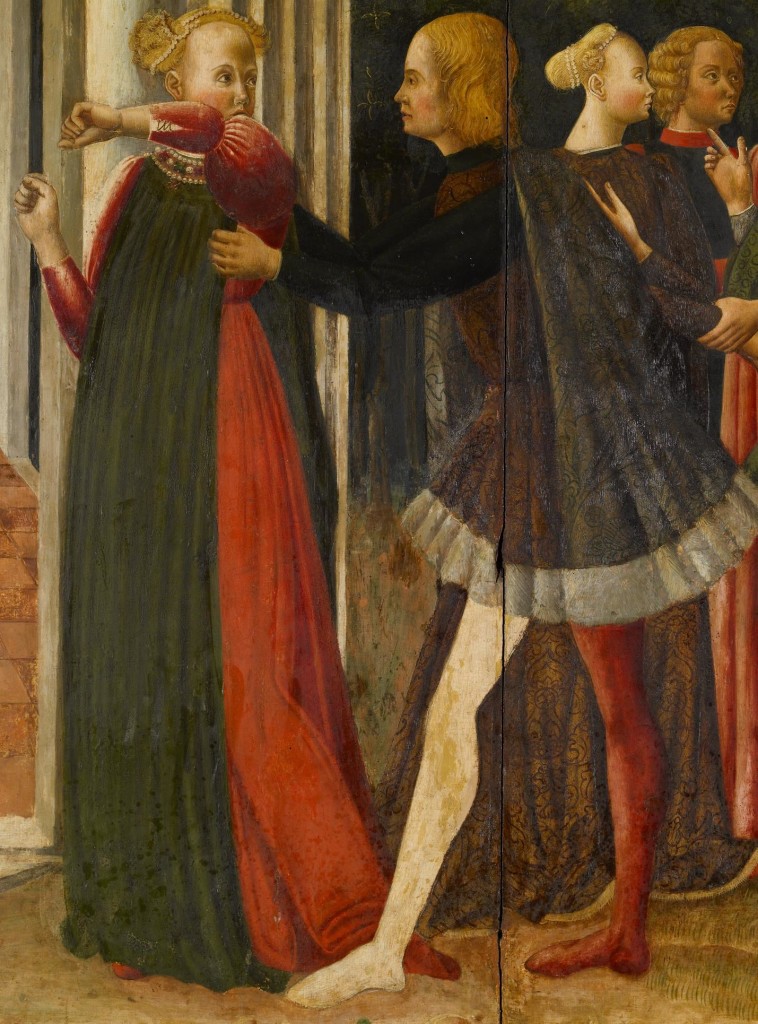In November, the WCG held their meeting at the Walters Art Museum where the Walter’s Painting Conservation Staff –Eric Gordon, Head of the Department, Karen French, Senior Conservator, and Pamela Betts, Associate Conservator –presented their on-going treatment of three Italian wall panels or spalliere.
The presentation’s title “The Face that Launched Ten Thousand Conservation Hours” was inspired by the six year period dedicated by themselves as well as fellows and interns working on the panels. To date, they have finished two panels and are currently completing the third.

The presentation began with Eric providing a historic context to the three panels which depict scenes from the Helen of Troy narrative -the Abduction, the Embarkation, and the Reception. The large size, the subject matter, and the fact that these panels remain together contribute to making the series special. The panels came into the Walters collection in 1915 from a palazzo in Tuscany and they are stylistically dated to the 1450s. Extensive research was conducted to try and identify the artist. The most convincing connection made was to an unknown artist whose collection of drawings are within a book owned by Giovanni Marcanova. The underdrawings of the panels, captured by infrared photography, have remarkably similar renderings of architecture and foliage to those in the books. Previous research led to the discovery of a panel at the National Gallery in Australia that is very likely associated with the series. Not only was it a match stylistically, one of the Walter’s panels had an inserts matching in wood and shape, which most likely indicates they were hung on opposing sides of a corner in a room.
Pamela presented the findings from technical studies conducted on the three panels, which provided insights into the structural components, materials, and design elements. Analysis of the panel revealed that it is spruce rather than poplar, which is more common. Since artists tended to use local wood sources and spruce only grows in the outlying areas of Northern Italy, it indicated that the panels (and artist) may have come from that area. The artist relied heavily on measured incisions to create accurate architectural features and free-hand incisions to outline people and their clothing. Various analytical techniques were used to identify the pigments as azurite, malachite, verdigris, vermillion, lead white, red lead, lead white, tin yellow, red, yellow, and brown earths, indigo red lake, and gold leaf.
In my opinion, there were two aspects of these panels revealed in the technical study that were remarkable. First, an x-ray of one of the panels revealed a full rendering of a dog who was hidden by overpaint. They were able to uncover the dog and bring it rightfully back to the painting. Secondly, though probably the more impressive of the two, was the technology revealed behind the highly decorated and embellished brocade garments depicted on the people in the panels. These garments were created using a technique known in German as pressbrokat, where a pattern is incised into a mold, then tin foil is pressed into the mold and the foil is then adhered to the painting backed on the reverse with drying oil and pigments. The visual effect of the garments is currently diminished due to their condition, but the x-ray revealed intricate patterns of pomegranate flowers, thistles, and some surreal foliage. It was not hard to image the effect they would have originally had on the viewer.
Karen had the difficult task of summarizing five years of treatment into the last section of the presentation. The panels had been in storage for decades because of the poor condition. At some point in their history, the panels were thinned extensively prior to cradling, which critically affected their strength. One panel was last treated in the 19th century and the other two were most recently partially treated in the twentieth. The panels have cradles on the reverse, and their British origin and date (1891) were miraculously identified by a scrap bit of newspaper wedged in an open join. Much of the treatment had to do with stabilizing the structure of the joining planks and adding additional strengthening to them due to the fragility of the panels. Aluminum channels were added to run along the length of the cradle. Animal glue and carvable epoxy adhesives were used to mend splits . Gap filling with an adhesive mixture of PVA resin, with coconut shell flour and phenolic microballons, along with metal hardware, were used along a major panel join. Metal pins found within the connecting section of the panel were replaced with wooden dowels to avoid the risk of rust in the future.
The treatment of the surface included removing varnish layers and overpaint, building up ground layers and inpainting. Various solvent mixtures and gels were used to remove the tough varnish layers and overpaint. In some places, they were lucky and found fill material and overpaint over intact painted areas. In other areas, such as the sky, they removed overpaint and found exposed ground. Fills were done in a traditional method using rabbit skin glue and gesso. Gamblin colors were used for inpainting, these layers isolated with a varnish layer.
The presentation by the three conservators was a testament to the collaborative effort required for such an immense undertaking. The night concluded with a tour into the gallery where two of the three panels are currently on display.
The three panels can be viewed on the Walters Art Museum website:
- https://art.thewalters.org/detail/31171/the-reception-of-helen-at-troy-by-priam-and-hecuba/
- http://art.thewalters.org/detail/8986/the-departure-of-helen-and-her-entourage-for-cythera/
- http://art.thewalters.org/detail/16311/helen-eloping-with-paris-from-cythera/
By Caitlin Mahony
Head Count: 47